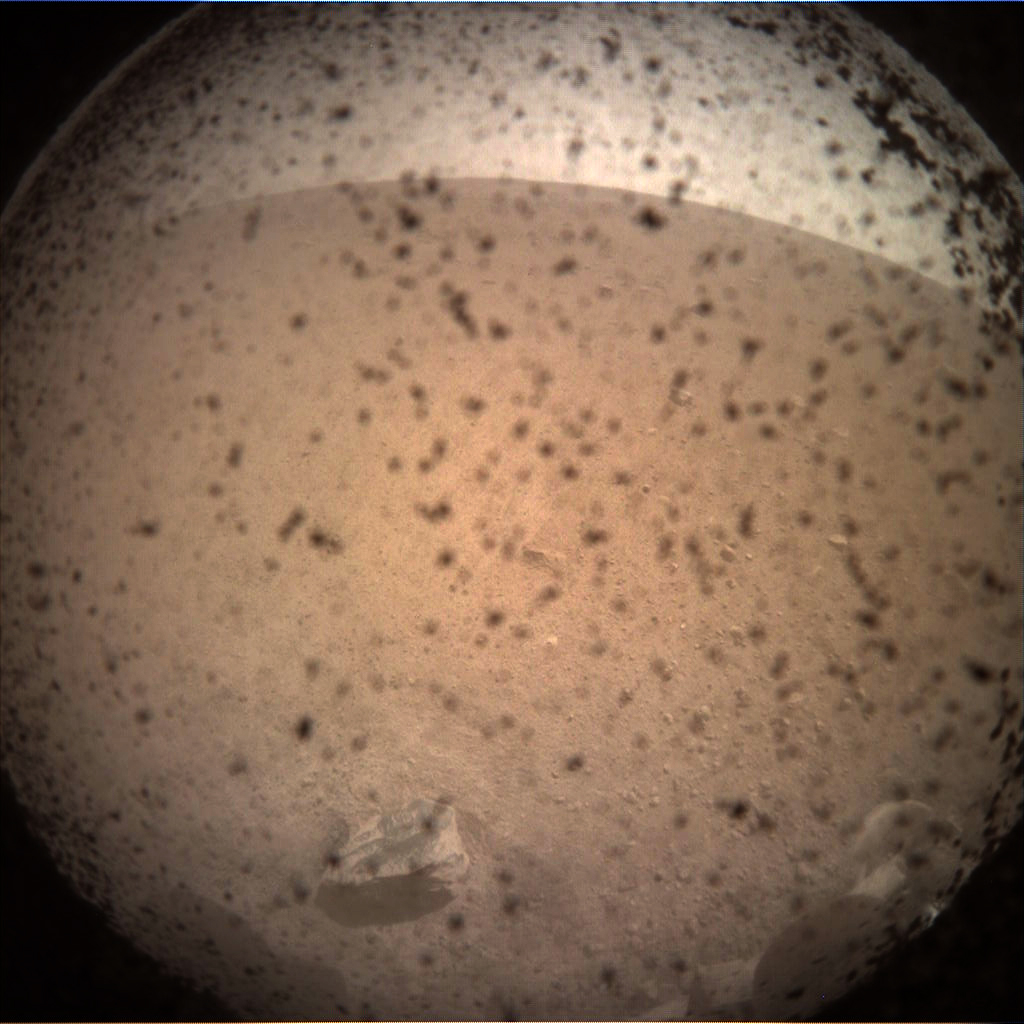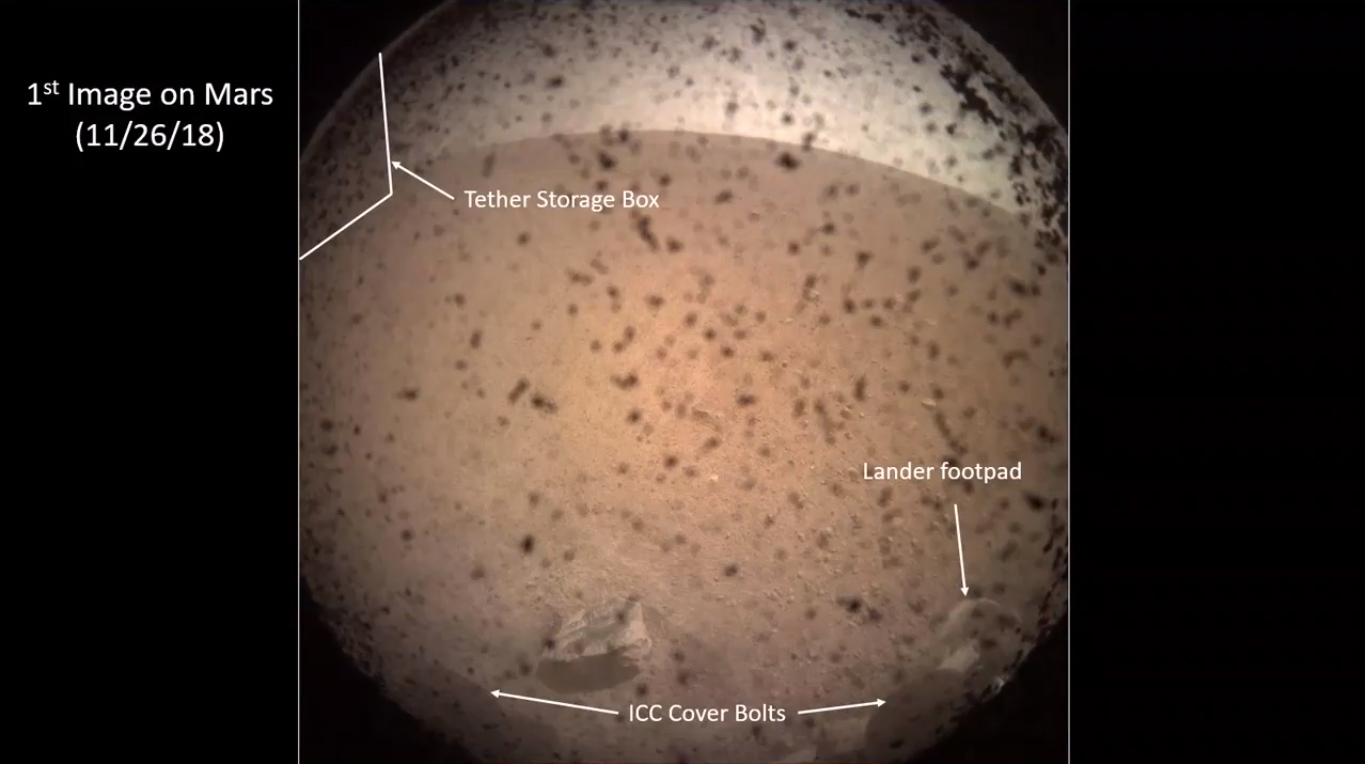Behold! Here's the 1st Photo from Mars from NASA's InSight Lander.
PASADENA, Calif. — NASA's newest Mars robot has already captured a photo of its rusty, dusty home.
The InSight lander touched down on the Red Planet today (Nov. 26) just before 3 p.m. EST (2000 GMT) and beamed home its first image from the surface mere minutes later. (You can see more amazing InSight Mars landing day photos here.)
"There it is!" Rob Manning, chief engineer here at NASA's Jet Propulsion Laboratory (JPL), said during live landing commentary today. "There is the horizon back there, the bluish sky. That's part of the lander deck on the front left." [NASA's InSight Mars Lander: Full Coverage]
The photo is speckled with black dots — probably particles of dust picked up during InSight's harrowing descent through the Martian atmosphere, Manning said. Future InSight images will be much clearer, after the camera's dust cover is removed, he added.
The image was beamed back to mission control with the aid of the two briefcase-size Mars Cube One (MarCO) spacecraft, which launched along with InSight this past May. The MarCO duo were tasked with showing that cubesats can explore interplanetary space, and NASA hoped the tiny probes would also be able to relay data home from the lander during entry, descent and landing activities today.
So, mission very much accomplished for MarCO-A and MarCO-B, which flew by the Red Planet today as Insight barreled into the atmosphere.
The stationary InSight lander is now settled on a relatively featureless equatorial plain called Elysium Planitia, about 340 miles (550 kilometers) from Gale Crater, where NASA's Curiosity rover touched down in August 2012. But InSight team members will be on pins and needles until at least 8:35 p.m. EST today (0135 GMT on Nov. 27); that's the earliest possible time they could learn that InSight's solar arrays have deployed as planned. (This news must be relayed via NASA's Mars Odyssey orbiter, which won't be in position until that time.)
Breaking space news, the latest updates on rocket launches, skywatching events and more!
InSight aims to carry out the first-ever in-depth investigation of the Martian interior. The lander will do this using a burrowing heat probe and a suite of three seismometers, which will measure tiny "marsquakes." Mission team members will also track the wobble of Mars' rotation axis using InSight's communications equipment.
These observations should allow mission scientists to map the Red Planet's interior structure in 3D — information that should, in turn, shed light on the formation and evolution of rocky planets in general, NASA officials have said.
The focus on the Martian subsurface explains why InSight landed on the flat, boring Elysium Planitia: It provided a relatively safe landing zone, and its scarcity of visible boulders also bodes well for the heat probe's ability to get deep underground (up to 16 feet, or 5 meters).
And the lander's first image offered some good news along these latter lines.
"It looks like there’s not a lot of rocks in the field of view," Manning said.
InSight must drop the heat probe and seismometers onto the Martian surface. This deployment probably won't take place for two to three months, mission team members have said. It will take another month or so to calibrate the gear for use on the Red Planet.
InSight's $850 million mission is scheduled to run for nearly two Earth years. It may take about that long for the lander to gather enough data to complete its mission goals, team members have said.
"InSight" is short for "Interior Exploration using Seismic Investigations, Geodesy and Heat Transport."
Mike Wall's book about the search for alien life, "Out There" (Grand Central Publishing, 2018; illustrated by Karl Tate) is out now. Follow him on Twitter @michaeldwall. Follow us @Spacedotcomor Facebook. Originally published on Space.com.

Michael Wall is a Senior Space Writer with Space.com and joined the team in 2010. He primarily covers exoplanets, spaceflight and military space, but has been known to dabble in the space art beat. His book about the search for alien life, "Out There," was published on Nov. 13, 2018. Before becoming a science writer, Michael worked as a herpetologist and wildlife biologist. He has a Ph.D. in evolutionary biology from the University of Sydney, Australia, a bachelor's degree from the University of Arizona, and a graduate certificate in science writing from the University of California, Santa Cruz. To find out what his latest project is, you can follow Michael on Twitter.


